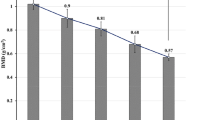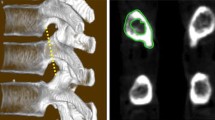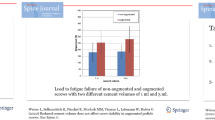Abstract
Several types of pedicle screw systems have been utilized to augment lumbar spine fusion. The majority of these systems are made of stainless steel (Ss), but titanium-alloy (Ti-alloy) devices have recently been available on the market. Ti-alloy implants have several potential advantages over Ss ones. High bioactivity and more flexibility may improve bone ingrowth and mechanical fixation, and the material also offers superior magnetic resonance imaging (MRI) and computed tomography (CT) resolution and significantly less signal interference. However, no data are available from loaded spinal constructs regarding bony ingrowth and mechanical fixation. The aim of this study was to analyse the effect of Ti-alloy versus Ss pedicle screws on mechanical fixation and bone ingrowth in a loaded mini-pig model. Eighteen adult mini-pigs underwent total laminectomy and posterolateral spinal fusion at L3-L4, and were randomly selected to receive either Ss (n = 9) or Ti (n = 9) pedicle screw devices. In both groups, the device used was compact Cotrel-Dubousset instrumentation (Sofamore Danek) of an identical size and shape. The postoperative observation time was ¶3 months. Screws from L3 were used for histomorphometric studies. Mechanical testing (torsional tests and pull-out tests) was performed on the screws from L4. The Ti screws had a higher maximum torque (P < 0.05) and angular stiffness (P < 0.07), measured by torsional testing. In the pull-out tests, no differences were found between the two groups with respect to the maximum load, stiffness and energy to failure. No correlation between removal torque and the pull-out strength was found (r = 0.1). Bone ongrowth on Ti was increased by 33% compared with Ss ¶(P < 0.04), whereas no differences in bone volume around the screws were shown. Mechanical binding at the bone-screw interface was significantly greater for Ti pedicle screws than for Ss, which was explained by the fact that Ti screws had a superior bone ongrowth. There was no correlation between the screw removal torque and the pull-out strength, which indicates that the peripheral bone structure around the screw was unaffected by the choice of metal.
Similar content being viewed by others
Author information
Authors and Affiliations
Additional information
Received: 9 August 1999/Revised: 8 December 1999/Accepted: 22 December 1999
Rights and permissions
About this article
Cite this article
Christensen, F., Dalstra, M., Sejling, F. et al. Titanium-alloy enhances bone-pedicle screw fixation: mechanical and histomorphometrical results of titanium-alloy versus stainless steel. E Spine J 9, 97–103 (2000). https://doi.org/10.1007/s005860050218
Issue Date:
DOI: https://doi.org/10.1007/s005860050218




